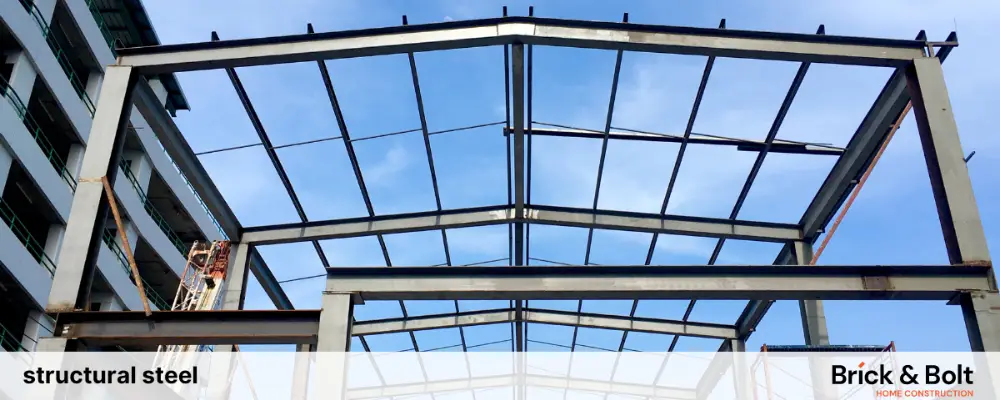Structural steel is one of the world’s most important construction materials today. It is a major framing material for practically all modern constructions and infrastructure. It’s valued for its strength and resistance to decay. This guide covers what structural steel is, its properties, types, uses, composition, shapes, and applications. Engineers and builders need this knowledge to make informed decisions in construction.
What Is Structural Steel?
Structural steel can be referred to as a particular type of steel made specifically for use in constructionThis type of steel may be said to differ from others in that it assumes shapes and sizes that endow it with excellent engineering performance in its application. The major components of structural steel are iron and carbon. The carbon content is kept within certain limits so that it will have higher strength and ductility.
It can be bent without failure, making it suitable for construction.
Structural Steel Properties
Structural steel has several key properties, which include:
High Strength
The high strength of structural steel allows it to bear loads as great as those that exist. It is, therefore, ideal for the building of skyscrapers, bridges, and manufacturing plants. Its impervious nature towards weather, rust, and corrosion makes this material long-lasting. The latter also ensures a long life of the construction and facilities, even in rigorous conditions.
Ductility
Ductility can also be described as the ability to deform without breaking. This property is critical for structures that may face earthquakes. They must absorb the energy of the impulse without collapsing.
Weldability
Structural steel is easy to weld. So, it can be assembled and fabricated on construction sites. It allows fast connections of different portions of a structure.
Types Of Structural Steel
Structural steel may be of numerous classes, for example:
Plain Carbon Steel
Carbon steel, with a certain content of carbon, is the most common kind of structural steel. One category of steel is the construction grade, which is highly useful in the field.
Alloy Steel
Alloy steel contains additional elements, for example, manganese and nickel. Those elements improve some specific features of alloy steel, like toughness or strength. This is one of the reasons alloy steel is utilised in demanding applications.
Stainless Steel
Rust is one enemy, among many others, that stainless steel is known to remain impervious to. It finds its use in kitchens, hospitals, and other places where sanitation is very important to be maintained.
High-Strength Low-Alloyed Steel
HSLA steel is stronger and more corrosion-resistant than carbon steel. It’s typically used in buildings that require strength without adding much weight.
Uses of Structural Steel
There are numerous applications for structural steel. Some of the common uses include:
Buildings
The skeleton that stabilises and supports forces that commercial and residential structures are prone to is mainly composed of structural steel.
Bridges
Structural steel is used in the construction of many bridges because of its high strength and toughness that allow spanning of long distances with safety. Steel bridges can support heavy loads of traffic and the earth’s tough weather conditions.
Industrial Structures
Structural steel is used in the framework of factories and warehouses, which makes it very practical for its use under heavy machines and equipment.
Transportation
Structural steel is used in various ways in the construction of railways and highways.
Energy
The very high strength of structural steel is used in other applications that require the lowest amount of steel attainable in the overall construction. As well as in the structure of power plants and wind turbines, structural steel may be used to erect a variety of renewable-energy structures.
Composition of Structural Steel
Structural steel is based on iron and contains 0.1% to 1.5% carbon. Various additives can be put into molten iron to impart strengthened properties to the resulting steel:
Carbon
The strength increases with the addition of carbon but ductility decreases. A good balance is required for structural use.
Manganese
It increases toughness and hardening, allowing the steel to resist wear..
Silicon
It is added to provide increased strength and improved oxidation resistance.
Nickel
The addition of nickel enhances toughness and, in that connection, increases the ability of the steel to resist high-temperature conditions.
Chromium
It enhances corrosion resistance and increases hardness; is, in fact, a constituent mostly present in stainless steel.
Structural Steel Shapes
There are many shapes that structural steel comes in, and they are used for a variety of different notions. Some of the more common basic shapes are:
Angles
These are L-shaped structural members used for bracing and supporting structures, widely used in frames and connections.
Tubing
A steel tube is a hollow section that can be applied in many forms, from columns and frames to railings, whereby its shape combines strength and light weight into.
I-Beams
An I-beam is a beam whose cross-section looks very much like the letter ‘I’. It helps the beams and girders to support each other, leading to one of the most common shapes used in construction.
H-Beams or Wide Flange Beams
Wide flange beams are those whose flange section goes beyond the standard I-beam, for providing greater support in heavy construction.
Channels
Channel sections are used mostly for framing and support. They are primarily applied in walls and roofs to give stiffness to the whole frame construction.
Plates
These flat, thin components have many uses. They are applied in flooring, general fabrication, bridge-building, and Steel reinforcement.
Rods
Steel rods find applications in many areas dealing with reinforcement and others on a structural basis; they frequently exist in concrete structures for carrying extra strength.
Conclusion
Structural steel retains its significance in modern construction and engineering. Its strength, durability, and versatility allow it to be used for a wide range of applications, from buildings to bridges. Structural steel’s properties and applications shape modern construction. Builders and engineers must grasp its nuances to make informed decisions.

